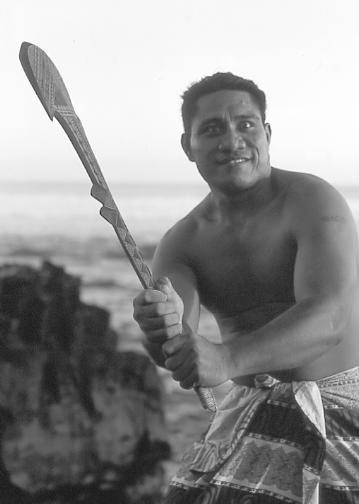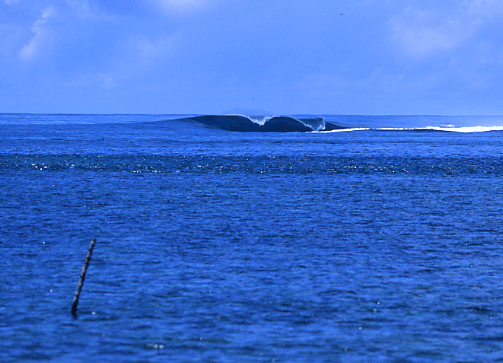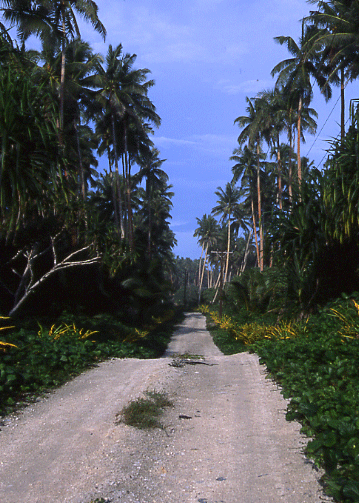By Michael Kew









THOSE EYES. Round, black, soothed by salt air and mossy, spicy, rotted-earth tang of tropical rain forest.
“Tofa soifua.”
Goodbye. A chance encounter with a South Pacific beauty. Dressed in white, off solo to evening church, flower adorning her left ear. She broke from the beach with a final back glance, casting another soft smile as I waded into the lagoon for a swim.
Tofa soifua—yes. Forgotten? No.
Dusk now. Coconut palm fronds sweep over the beach as I pick barefoot over coral and lava, drawing deeper into the 87°F sea. First immersion and I’m away from the North Pacific and all of its frigid reverences, springtide gales, woods, white sharks, hypothermia. One-third of Earth is Pacific, larger than all lands combined, and here was its lower half—a warm wet, unlike the March gray I’d abandoned in California days prior.
As was the rough midnight drop through the clouds into Faleolo Airport, Apia. Last off the jet, through the emptied Air New Zealand rows and farewelling stewardesses, I pressed straight into Upolu’s sublime stickiness—another warm wet, this one nosed with sweat, bloom, and soil. Entrance to the unspoiled heart of Polynesia.
"THERE IS A TWO DIFFERENT PEOPLE HERE IN SAMOA." Lots of Samoan, they know how fishing. They’re the people who not afraid about the ocean. But the people who not know how to fish, they afraid about the ocean. But Samoan island is still same as the Hawaiian people—they like ocean.”
Magenta floods the early sky as I converse with Vai, resort employee and one of Samoa’s native surfing handful. We are aboard the resort’s 34-foot aluminum twin-hulled vessel engulfed by the absolute essence of morning: sunrise at sea.
South shore’s Aganoa Point. Built of jagged black lava, it is robed in rain forest, further softened by summit mists and verdant skylines spilling to the ocean. Daylight reveals empty triple-overhead lefts detonating against deep-set lava reef. Stand-up barrels for anyone with experience and a pintail. With a leap of courage over the gunwale, we are surfing.
Nine hours later, I swill a lager and muse about the virtual nonexistence of native Samoan surfers. Saia describes it this way:
“Many surfers from overseas ask me about any Samoan surfing before. They try to find the history—is there anyone here in Samoa who took place in surfing? Well, there’s a legend story about the one Samoan surfing. It is a true story. We use it here now for our speeches.
“So, in American Samoa, there’s a village named Afono. One day, the people wake up in the morning and look out to the ocean. There’s a man who’s surfing the waves, from the reef, going back beyond the reef, go back…like that. And the people stand on the beach and wave their hands. They try to chase him. ‘Who’s that man? Get off! Get off!’ Like that. So the man run away from that island of American Samoa from the village of Afono and stay here in a village on Upolu. The village is very straight from American Samoa to here.
“At that time there was a very big fight in the villages here on Upolu. That man came and lived here in this village where that fight happens. All the villages, they prepared for a fight. So this man included in this group. They don’t know who he is, where he from. When the fight ended, he’s a different man. This a man who won the fight. But this a man from Afono, from the village of American Samoa, so they chase him out.
“Afono villagers, they know the stories about the fights here. They know that’s the man they chased out from their village, so there’s a Samoan proverb which means Afono missed their blessing. They’re lucky from this man. That man surfing, the one who surfing is a very hero man. And I know that this history of surfing is a very long time ago took place. Because there’s a man in American Samoa who surf. He’s a hero man, know everythings. Good in a tide, in a ocean. When he go out there, he know how to surf. When he go on land, he know how to fight. He’s a hero.
“That is the story and history I know from long time ago. Lots of Samoans, they know it. We have a special proverb like if you missed something, or you just throw something away, the people say, ‘Ah, you missed your blessing’ or ‘You missed your lucky.’ They missed chance to learn surfing.”
POLYNESIAN TRANQUILLITY comes with a sinking sun into palm silhouettes. Four more breaststrokes and I can’t touch lagoon bottom. Stop and tread water, blink the eyes clear and see the girl vanish into riotous vegetation, from the beach back onto the coral road. It was a pleasant stroll. A detour.
Many attend church at this hour. Others commune in social centers, rugby fields, dinner mats in spartan homes. Down at the resort, now a faint glow to the east, Saia serves cocktails. “I surf the waves with my eyes,” he said to me earlier, pointing to his face then to the ocean. One day, he claims, it will be with a surfboard. Still treading, I think of this and look south. Dim horizon fuzz grows pale with broken swell hitting the barrier reef. No surfing out there.
The girl is gone and so is the sun. Twilight resplendence suffocates all else. Here, just offshore Salamumu, I drift on my back, ears filled with muffled wave energy. Close the eyes then open them to the evening star. I try to envision these people at war once with Tonga, or with the rough sea and reefs in fishing canoes, with the Christian white man invasion, with natural disasters, with the tattoo needle. All overcome. For now, it is Samoan idyll.
Fa’afetai tele.